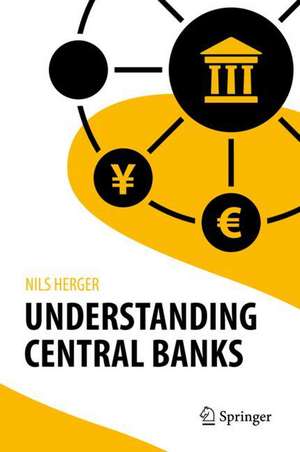Understanding Central Banks
Autor Nils Hergeren Limba Engleză Hardback – mar 2019
Preț: 255.97 lei
Nou
Puncte Express: 384
Preț estimativ în valută:
48.98€ • 53.37$ • 41.27£
48.98€ • 53.37$ • 41.27£
Carte disponibilă
Livrare economică 02-16 aprilie
Livrare express 18-22 martie pentru 62.40 lei
Preluare comenzi: 021 569.72.76
Specificații
ISBN-13: 9783030051617
ISBN-10: 3030051617
Pagini: 214
Ilustrații: XI, 200 p. 47 illus., 45 illus. in color.
Dimensiuni: 155 x 235 x 20 mm
Greutate: 0.48 kg
Ediția:1st ed. 2019
Editura: Springer International Publishing
Colecția Springer
Locul publicării:Cham, Switzerland
ISBN-10: 3030051617
Pagini: 214
Ilustrații: XI, 200 p. 47 illus., 45 illus. in color.
Dimensiuni: 155 x 235 x 20 mm
Greutate: 0.48 kg
Ediția:1st ed. 2019
Editura: Springer International Publishing
Colecția Springer
Locul publicării:Cham, Switzerland
Cuprins
Introduction.- A Brief History of Central Banks.- Money: Lubricant of the Economy.- Monetary-policy Instruments.- Money, Credit, and Banking.- The Initial and Final Effects of Monetary Policy on Inflation, Output, and (Un)employment.- Central-bank Independence.- International Monetary Policy.- Final chapter: The Past, Present, and Future of Central Banking.
Notă biografică
Dr. Nils Herger is a lecturer at the Study Center Gerzensee - the research and training center of the Swiss National Bank. His main responsibility is to organize a course program for central bankers, which is attended by participants from all over the world and enjoys an excellent international reputation. Nils Herger also teaches monetary policy and macroeconomic topics at the University of Bern. He holds a Ph.D. in economics from the University of Exeter.
Textul de pe ultima copertă
Issues related to central banks feature regularly in economic news coverage, and in times of economic or financial crisis, especially when a commercial bank is bailed out, they become the focus of the policy debate. But what role do central banks play in a modern economy? How do central banks wield influence over the financial system and the broad economy? Through which channels does monetary policy impact macroeconomic fundamentals such as inflation or unemployment? For example, how does a central bank alter the money supply? What are the benefits of central bank independence, and what are the up- and downsides of having a common currency? This book provides easily accessible answers to these and other questions associated with central banking.
Caracteristici
Helps the reader understand the role central banks play in modern economies Fills a gap in explaining the role of central banks, their historical development and the effects of montary policy in an intuitive manner Written for the general audience and for students in economics, political science, law, history etc
